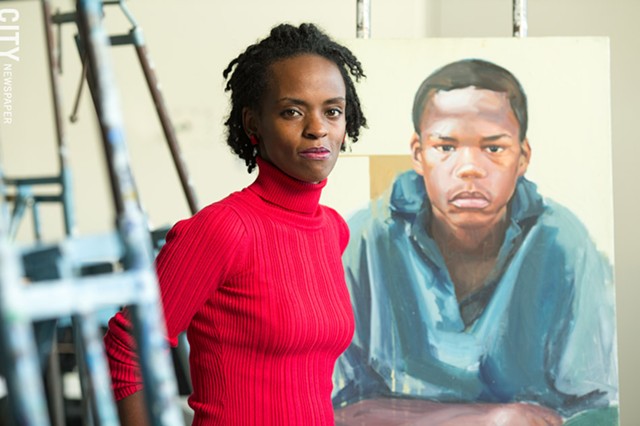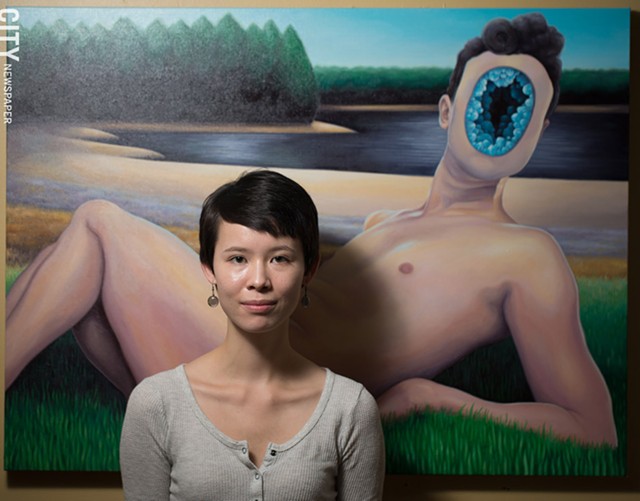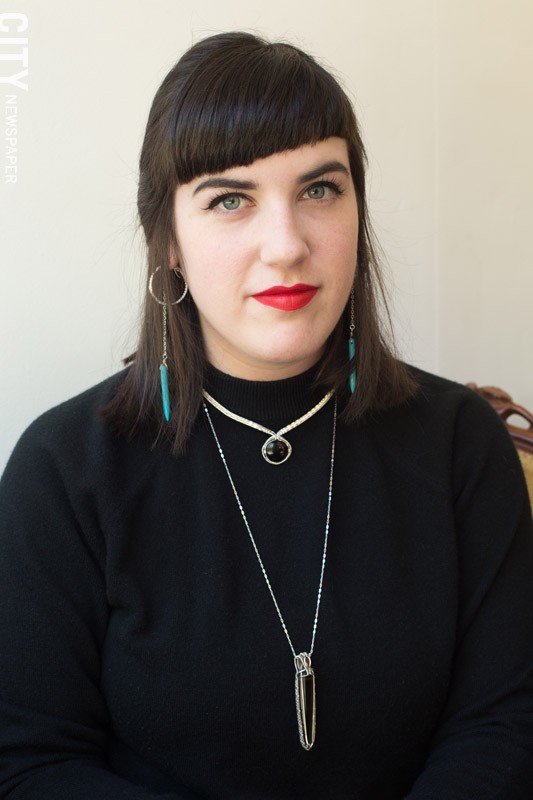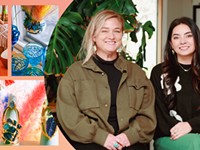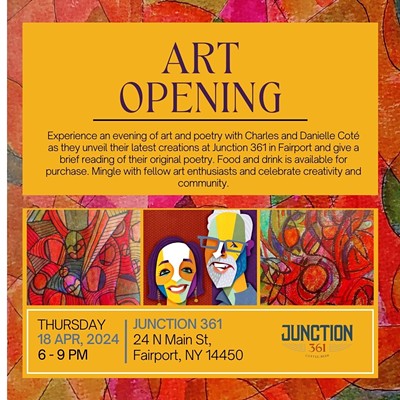
[
{
"name": "500x250 Ad",
"insertPoint": "5",
"component": "15667920",
"parentWrapperClass": "",
"requiredCountToDisplay": "1"
}
]
Each year, City Newspaper highlights four Rochester artists who are not yet household names, but are creating engaging work that's been garnering attention. The following four emerging artists — Holly B. Heckler, Athesia Benjamin, Melissa Huang, and Marissa Kalen — come from diverse backgrounds, are at different points in their career paths, and pursue different aesthetics.
Heckler and Huang flex their talents painting unabashedly pretty scenes inspired by nature and the human figure, which also contain a magnetic level of mystique. Benjamin tackles political and social concerns in a variety of media. And Kalen creates the chicest updates of the wire-wrapped jewelry tradition.
Pursuing a career in art isn't like other fields — there are few ready-made opportunities, so most artists must construct their paths with as much intrepid skill as they put into their actual craft. Many young artists end up letting their own work simmer on the back burner while earning their bread. These four have found ways to keep their creative practices thriving, whether by choosing careers that allow a daily connection to the arts or by dedicating more time to making work after starting a family. These four artists caught our attention with their adamant approach to art.
Holly B. Heckler: Carrying a classical torch
I don't know if I've met someone more aptly named than Sodus-native Holly B. Heckler. The 25-year-old artist has an almost forensic approach to painting plant life (in addition to her astoundingly beautiful portraiture), and she's unapologetically assertive about getting what she wants out of life.
Having exhibited early artistic promise, Heckler earned a scholarship to study in Steve Carpenter's studio in Rochester while she was still in high school. She learned to draw and paint directly from the figure, and though this early classical training put her at an advantage when it came time to apply for college, it also created some frustration. She was so far ahead of her peers at Pratt that she felt underwhelmed and limited by the instruction and environment.
Heckler transferred to Alfred, where she developed an ardent approach to her education. "If I'm paying a lot of money for something, and I feel it's not the program I signed up for, I'm going to question and challenge it," Heckler says. While she painted at her apartment to avoid the distractions of the public studio, she led the critiques for her classes as well as others in the painting department.
Today, Heckler works from a shared studio space in her Rochester home. Her oil paintings tend to be largescale depictions of unexpected moments of fascination with something in her environment.
"Every single painting has happened differently," she says. "I'll just be out with people I know, and notice the lighting, and say, 'Stay where you are!' I'll take 100 pictures, and then sketch. I don't have premeditated scenes in my head. I'll walk by a flower bush, be struck by the beauty, and then I'll paint it."
And she perfectly conveys what she sees — although her paintings can be straightforward, representational images, she captures the calming, magnetic pull of every curling leaf. Petals seem to shiver as cold light passes through them.
Her figurative subjects, alone or in pairs, typically have a brooding quality in their posture or gestures and the far-off expressions.
"I find that's when you see somebody, when they're not looking," she says. "When you can watch them observing and thinking their thoughts, you almost see more. When you're looking somebody in the eyes, there's a self-consciousness."
There are subtle narratives and private meanings behind some of the symbolism she paints. One in-progress work is from photo references snapped at a gathering after the funeral of her best friend this past summer.
"A group of us hadn't seen each other in seven or eight years," she says. "We all got together and couldn't leave each other. I'm painting one of the guys I met down there. We were having coffee, and the colors were perfect, and now that's a painting I'm doing." Heckler says the work isn't about the man in the photos, but about her late friend. "She's in there, with the style of my brushstrokes; there's symbols hanging in there, too."
"I think I want to make wallpaper," she muses, pointing out the gentle trail of vines on the wall behind the young man — a part of the work she made up. "Half of this is a photo I took at a café, but I took like 50 photos, and exaggerated the colors and made up patterns. This orange-pink color in the shirt is the underpainting, the color I painted the canvas. It was a black and white striped shirt, but I'm just going to leave that. This painting was about the colors and the purity of thought. It's a raw, open, straightforward painting."
Because of Heckler's tendency to reuse canvases multiple times, there can be an element of palimpsest in her work. The jacinth swath of fabric laid over the back of the couch in this work was part of a different painting, which was oriented the other way. "It was a still life-with all of this fabric in the front. When I sketched him over the painting, the two shapes met in such a way that I said, 'Oh, I'm keeping that.'"
Heckler has five unfinished paintings currently in progress, on hold. She hasn't lost interest — in fact she is itching to finish them — the delay is due an ongoing battle with materials. "I've become really fed up with the quality of paintbrushes," she says. "I have to buy new ones like three times during a painting. I can't find any, no matter how expensive they are, that will last, that will retain their elasticity. I've thrown them all out, so I've just been drawing a lot."
These from-life, massive renderings are the result of sitting in her garden and drawing. "I always need to have something growing and something beautiful around me," she says. "I need flowers all of the time. In the winter I buy them every week. It's the colors and the shapes, they're just perfect; they blow my mind."
Heckler's work is included in a group show at Bug Jar (219 Monroe Avenue) through late November. See more of her work on Instagram at @hollybhecklerpainting.
Athesia Benjamin: The medium serves the message
I became aware of Athesia Benjamin's artwork after hearing her interviewed on Sabra Wood's WAYO radio show, The Graphic Ear. Though the 37-year-old Rochester native leads a busy life as a mother of four and full-time professor in the art department at Monroe Community College, she says she feels anxious when her hands are empty.
Now that Benjamin's youngest child is in school, she's incrementally been reclaiming some of her time for her creative pursuits, which include but aren't limited to illustration, collage, painting, and ceramics.
"I've found that I'm sort of an artistic chameleon," she says. "For me, it's always been about experimenting. I don't feel the need to carve out just one niche, I want to try new things."
The materials Benjamin selects for each artistic endeavor are contingent upon the specific message she's trying to convey. She keeps a blog at 2016electiongotmelike.blogspot.com where she posts political cartoons she makes in response to the United States' disturbing social and political climate. These drawings are critical of both Trump and Clinton — one older post was a visualization of Clinton's infamous comments about "super predators."
Benjamin has a little workspace carved out in her house — a couple of desks between a couch, keyboard, and computer where her kids might be playing. "Instead of feeling like I cannot produce, because I don't have the luxurious amount of time I had as a student, instead of putting all creating aside, it's like, 'What will my work look like if I only have five minutes to bust something out?'" she says.
Benjamin has been recently making unique ceramic planters, which she creates by filling a stocking with rice, covering the form with slabs of clay, and dropping it to the ground from a height. "Gravity pushes that malleable clay onto the rice form," she says, and the clay picks up lines and impressions. "It's experimental; I don't know what I'm going to get, and that's exciting," she says.
The organic, freeform vessels don't feel like containers in a strict sense: they have an openness that feels fresh. They may remain unglazed or the inside of a shell-like structure might have a shimmering, nacre glaze. She says she finds the tactile, responsive nature of working with clay to be therapeutic, as is the notion that people have been working with clay since the beginning of time.
When Benjamin was a student, she painted a series of portraits of black people. She's thinking about revisiting that work, and has begun to take reference photos for the new generation of these paintings.
"I feel like the paintings would serve a different purpose now," she says. "With all that's been happening in the country, racially, and the fear that has always been there concerning black bodies, and brown skin ... I feel like that work would serve this purpose: if our bodies and our skin isn't respected, is feared out in real life, maybe it takes on a different feeling when it's on canvas."
Back when she was first working on these paintings, she said many white people would ask her why she painted black people. "It was so simple to me," she says. "These are the people around me. But to the viewer, it looked like I was avoiding the 'default' subject, which speaks of their own lack of awareness and lack of objectivity about themselves."
The original portraits were made when Benjamin was living in the 19th Ward. "Now I live in Brighton, so it felt right to take the pictures at the Liberty Pole, because we're all sort of coming from our own spaces to this central place," she says. "But I feel like I want to go back to my old neighborhoods, and try to recreate that. What's different? If I'm on Parcells taking a photograph of someone I think is interesting, I have that image, but how do I feel now? How will I feel different now that it's not really my neighborhood anymore? What will the work look like, now that my ZIP code is different? Am I appropriating? Am I using? I have to deal with that. And I think I'll deal with that through the first painting that I do."
See Athesia Benjamin's work at athesiapottery.blogspot.com.
Melissa Huang: Portraits of the inside
Every aspect of Canandaigua resident Melissa Huang's life is immersed in art, whether making it or facilitating others' experience of it. She creates glowing oil paintings that combine landscape, figurative, and still-life natural elements. She works as assistant to art appraiser Roz Goldman, and as a gallery assistant at Main Street Arts in Clifton Springs. And she's a member of the feminist art group, Politits Art Coalition, a girl gang that keeps its members regularly engaged in events and art shows. This fall, Politits will hold a pop-up group show at the Rochester Brainery.
Huang says she's always been a fan of figurative art, but that her earlier work was more straightforward, representational work. The surreal elements she's now known for — painting the shimmering cave-like interiors of geodes where faces should be — came later, after studying abroad in Florence. "I made a self-portrait with pomegranates coming out of my stomach, and branched out from there," she says.
The crystal face series came from a deep love of sparkly things, Huang says. But they're also metaphors for inner worlds and ideas of identity. Whether cracking a geode or getting to know someone, you initially have no idea what's on the inside. The smooth, usually nude bodies linger in atmospheric landscapes, the likenesses of the people disrupted by the concave spaces lined with the gleaming teeth of amethyst or celestine.
Aside from these crystal-faced wonders, she paints more straightforward portraits of friends, a growing series of bird portraits on small, gold-leafed panels, and portraits of trinkets and figurines. "I have lots of them around my house; it kind of looks like an old woman's been living there for a thousand years," she says with a laugh.
Huang grew up in a suburb of Chicago, and moved to the area to attend Rochester Institute of Technology. She began working with Goldman while an undergrad, and after graduating in 2014, she was immediately hired at Main Street Arts. Both jobs were suggested to her by RIT professor Alan Singer, who she praises for connecting his students with practical concerns and real world opportunities.
Huang says she loves both of her jobs for the connections they offer with a wide variety of artists and art lovers. "And I get to see people's art collections and learn what appeals to them, which is so much fun," she says. "Many of the collections include local people, so it's been interesting to research artists who were working here in the 1900's."
After completing courses online at New York University and receiving a certificate, Huang has recently set up her own art appraisal practice, and receives referrals from Goldman. Because Goldman's expertise is in fine art prints, and she works on important print collections, Huang has learned quite a bit about that genre of art. But she hasn't decided yet on an area of specialization for her own practice.
Check out Melissa Huang's work at melissahuang.com.
Marissa Kalen: Not your hippie mama's wire jewelry
I met Marissa Kalen a few years ago at a bar down the street from Ithaca's State Theatre, where we were dwelling over drinks before seeing a Neutral Milk Hotel show. The 25-year-old's style is a perfect blend of rocker, Mod, and ladylike, and is almost always accented with unique jewelry of her own design.
Mention the term "wire-wrapping" and what typically springs to mind is meandering metal lines cradling chunks of crystal that are sold alongside hemp and incense. Although Kalen's work does feature beautiful stones and crystals — or old iron keys, or vintage cameos — her wire working is much tighter, full of intricately woven geometric patterns. The effect is surprisingly sleek and versatile, blending modern minimalism with whiffs of witchiness.
She showcases stones and other objects in perfectly symmetrical reliquaries. Kalen works with silver, copper, brass, and gold-filled wires, and sometimes mixes them, getting both warm and cool tones in the piece. She begins with a thicker gauge, firm-tempered "base" wire to create a basic form, then uses a thinner, soft-tempered form to wrap around the thicker wire and achieve great detail.
Kalen has been working with wire for about a decade, since she took a jewelry class at Rush-Henrietta High. "That wire-wrapping portion was definitely my favorite part of it, and I stuck with it from there," she says. She's learned some basic wrapping techniques from the Internet, but has been developing her own personal aesthetic.
Some more recent experiments with just wire, no centerpiece, have yielded delicate chevron forms suspended from equally delicate chains. She's also been creating some elegant and modern takes on Victorian chokers, with vintage resin or ceramic cameo centerpieces surrounded by simple wire elements and silver chain draped at intervals. A friend commissioned a couple of necklaces with wrapped wire in the shape of the Deathly Hollows symbol from Harry Potter, which has become a popular design and yielded more orders.
A self-styled stone hoarder, Kalen sources her materials from a fellow artist she found on Ebay who specializes in Mexican turquoise and who makes cabochons from stones he mines himself. All metals come from a wholesaler that Kalen says she favors because "you can send back your scrap metal, and they'll melt it down and resell it." Her keys and cameos come from flea markets, vintage stores, and friends.
It takes Kalen between 45 minutes to two hours to create a small piece, and up to 12 hours for more high-end work. Her materials fit into a small box, which she can transport from her couch, where she often works, to a friend's house.
Marissa Kalen will be part of a show on November 19 at Gallery Salon. See more of her work in person at Jane Vintage on Gregory Street, on Instagram at @nightowl_roc and nightowlwireworks.etsy.com.
Speaking of...
-

Pandemic and racial reckonings fuel Black artists
Mar 1, 2021 -

Art and social justice series 'Black House Narratives' debuts Thursday
Nov 18, 2020 -
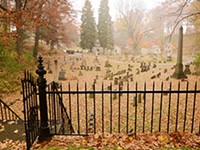
Mount Hope Cemetery: A buried treasure
Nov 13, 2013 - More »
Latest in Art
More by Rebecca Rafferty
-

Beyond folklore
Apr 4, 2024 -

Partnership perks: Public Provisions @ Flour City Bread
Feb 24, 2024 -

Raison d’Art
Feb 19, 2024 - More »

